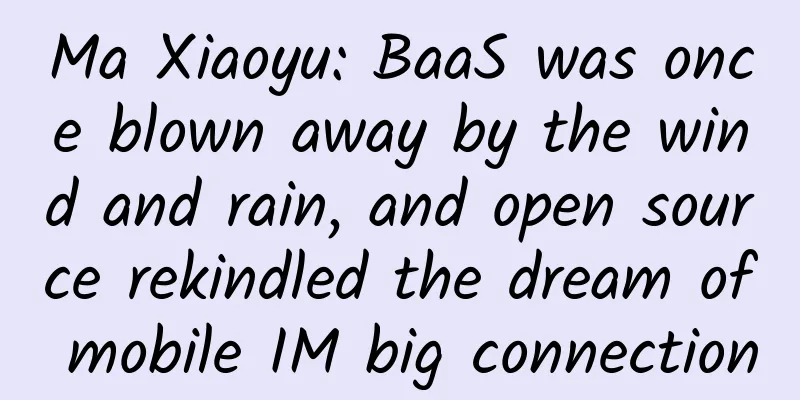Ma Xiaoyu: BaaS was once blown away by the wind and rain, and open source rekindled the dream of mobile IM big connection

|
In 2014, WeChat firmly controlled the domestic market with the unique advantages of QQ. Momo rushed to the US Nasdaq through capital reshuffle. Facebook bought WhatsApp with 19 billion US dollars and bought a future. When people thought that the mobile IM situation had been settled, many apps that moved towards social networking through mobile IM also received venture capital and joined this unpredictable war. Today in 2015, the mobile Internet will enter the era of activity. With the increasing dependence on mobile phones, user needs are constantly changing. With the rapid development of 4G, mobile IM has set off a battle for entry. Aaref Hilaly, a senior partner of Sequoia Capital, a well-known venture capital institution and a shareholder of WhatsApp, once said that mobile chat is redefining social networks. Social models such as Facebook, which are full of stranger relationships, have become worthless. Mobile IM will usher in a huge opportunity for innovation. Whether it is social networking, e-commerce, education, or even embedded fields, it can create a big connection era. "Our direction is instant messaging cloud, mainly for multiple terminals. In addition to the existing iOS, Android and Web terminals, we are actually working on Linux embedded, which will support more embedded devices and join IOT (Internet of Things) to realize the interconnection between devices." Talking to reporters about the development of mobile IM and the future direction of HuanXin, Ma Xiaoyu, HuanXin's CTO, expressed his big dream based on his practical experience and insights in the field of mobile communications. At the same time, as an open source idealist, he and the entire team are committed to gradually open source HuanXin and apply open source in the entire work environment, so that enterprises can follow the footsteps of the open source world, firmly move forward on the technical route, and make everything better.
Ma Xiaoyu, CTO of HuanXin, has been engaged in program development for 17 or 18 years, from the earliest IC design to the development of telecommunications SMS gateway programs and gateway software. He has successively joined Symbian and Nokia, engaged in middleware and kernel software development, and has profound accumulation in the field of mobile technology. It can be said that Ma Xiaoyu has been accompanying the growth of China's mobile Internet all the way. In the early days of the Huanxin project, Ma Xiaoyu and other project members saw the general trend of mobile Internet and the market demand, and wanted to provide IM and push services based on the BaaS platform, and build a complete BaaS platform in terms of Key-Value storage, user system, and permission management. However, the project lasted only half a year before being terminated. Faced with such a blow, Ma Xiaoyu and the entire team did not stop the development of the entire project. From irrational enthusiasm to bubble bursting, this made them more aware of the needs of users in the entire market, the importance of openness and the entire ecosystem. At the end of 2013, Ma Xiaoyu and his team set out again. They recycled all previous projects, repositioned and focused on one thing, that is, instant messaging business. As the mobile Internet continues to flourish, mobile IM is becoming more and more popular under the impact of the entire market. However, Ma Xiaoyu believes that the mobile IM field still has huge potential, and there is still a large part of user demand in the differentiated market. Therefore, they began to focus on platformization and portalization, and in addition to meeting users' instant messaging needs, they continued to expand vertically. It can be said that 2013 was the most difficult year for Ma Xiaoyu and the entire team. WeChat, Yixin, Fetion, Laiwang, Momo, etc. seem to have occupied the entire mobile IM market, but the form of mobile instant messaging applications is far from being finalized, and users are constantly adapting and iterating. Everything is full of uncertainty. Ma Xiaoyu and the entire team also saw this market. With the team's background in open source and mobile technology, they brought the Huanxin project to the stage of mobile Internet step by step. Behind the success, there are also many difficult decisions and direction choices. Now, let's follow the reporter to understand the choices and values that Ma Xiaoyu and his team made behind the instability in the mobile IM field. Reporter: What were your considerations when you and your entire team developed mobile IM products such as HuanXin? Ma Xiaoyu: The HuanXin project started in early 2013. At that time, we saw the big trend and demand of mobile Internet, and initially wanted to build a BaaS platform (Backend as a Service) to provide some IM functions. We also built a push function, added Key-Value storage, user system, permission management and other functions. Ultimately, we wanted to build a relatively complete BaaS platform, which lasted for more than half a year, and we found that this project was very difficult. The main problem is that BaaS is very good for small and medium-sized developers. It does not require its own backend and is easy to run. However, if your business develops, it is difficult to meet personalized needs and customization. In fact, we discussed this issue at the end of 2013. The BaaS platform basically cannot solve the personalized needs of users, so we later recovered the project and focused on doing one thing - that is, IM instant messaging. Since the end of 2013, we have repositioned ourselves and started to focus on the instant messaging business. The product was actually launched in the middle of 2014 and officially launched in June.
Reporter: People started talking about the BaaS platform in 2012. In 2013, more and more people were talking about integrating BaaS services on the mobile Internet. What do you think is more suitable to do with BaaS services? Ma Xiaoyu: It is particularly effective for small and medium-sized development teams. If you are developing a mobile app, you must first have your user system and key-value data storage. Then you can learn about push social networking and even the friend circle module, and you will find it easy to build such an app. However, it is difficult to meet the needs of users. Even if Key-Value can store different data, it is difficult to manage user permissions. Because some applications, for example, only the secretary of the leader can have a specific permission. So I think it is difficult to further expand the enterprise-level mobile application. We have been working on this BaaS platform for a year. Reporter: Is there any continuation? Ma Xiaoyu: No, but our team working on the BaaS platform all have a scientific research background. We chose Usergrid Apache, a famous open source project. Our main founder is also a Usergrid Committer. Through the evolution of technology, we developed HuanXin’s user system based on Usergrid. Reporter: It is understood that many executives of your team have backgrounds in important open source projects, and have rich experience in popular open source projects such as Jboss and Hibernate. Most users of platforms like HuanXin are developers, and you and your entire team are also users of your own products from a certain perspective, and you are the ones who understand your users the most. So what do you think is the most important thing for a product to be accepted by developers? Ma Xiaoyu: Yes, first of all, we use HuanXin, and we also use other developer tools, from statistics to some analysis, monitoring, and push. We think that the most important thing is service. Including when we were doing open source communities before, sometimes we also looked in the QQ groups of some sister companies. Basically, HuanXin is the only one where developers can find the main technical staff to reply to you at 2 or 3 o'clock every night. We have received very good reviews from service providers, which is also why we can win the recognition of developers now. Reporter: From the perspective of open source, HuanXin has open-sourced the SDK code of its instant messaging cloud, which is very helpful for developers to deploy their own applications. From this aspect, we can see HuanXin's attitude towards open source. Please tell us how you view open source and what are your plans for open source in the future? Ma Xiaoyu: First of all, we gradually open sourced our backend, because we don’t rely on the code itself. After all, instant messaging is almost a free market now, so we still have to rely on services to win the market. Another thing is that we have been working on open source for a long time. We wanted to take this opportunity to do some experiments with Huanxin, and we have been promoting it. We hope to achieve three successes with Huanxin. The first is commercial success. First of all, the product must be valuable. What we do is toD services for developers and SAAS services for enterprises. The third is that we can have income, a reasonable profit, and commercial success. The second is technical success. Our own technology stack uses not only our own developed technologies, but also a lot of excellent open source software, from middleware to databases, most of which are from abroad. We are solving the consumption level between mobile terminals and servers, or cross-platform deployment. So one of our goals, the goal of technical success, is to find an important problem, then make a solution as part of our commercial product, and at the same time open source it to attract users to use it. This is also what the entire team needs to do in the long run. The third is team success. Some of our team members have worked on open source projects and are more interested in the culture and spirit of open source companies. This team success is best understood, that is, if a colleague lives in Hainan, he can work in Hainan, get a salary in Beijing, and come to meetings every few months. We also began to try it gradually. After the Chinese New Year, a colleague worked in Thailand for a week and came back to share with us. We think the results are quite reliable. Working in a place that you are more yearning for or familiar with is completely different, and your thinking is particularly clear. So we hope to realize some open source corporate culture in commercial companies. Reporter: There are many instant messaging products on the market. I personally think they are all relatively mature. However, when the technology develops to a certain level, users often no longer care about which company has the best technology, but are more concerned about product experience and service attitude. In this regard, in what aspects do you think HuanXin can better demonstrate? Ma Xiaoyu: Now there are three aspects. On the one hand, the service is further deepened. I think connecting to the Huanxin platform and providing IM is just the first step. We now have a special CSM (Cluster System Management middleware specifically for cluster system management) to help our customers succeed. By sending messages to avatars, locations, ratings, interactions, push notifications, etc. in the first step, we can increase its activity and let users really play. So we have set up a special team to help these relatively large apps really analyze user indicators and how to help them interact more through our data. This is what we call customer success. The second step is actually what everyone is doing, which is data mining. Mining user behavior is actually very beneficial to the APP. For example, we have a user called liepin.com, and we can analyze some behavioral keywords of users and headhunters on it, and guide his business based on these data. The third step is that we are gradually realizing that after a certain number of users, instant messaging needs to maintain a long connection, so this has a certain cost. I think cost advantage is also an advantage. After an enterprise really reaches a million users, the monthly operation and maintenance cost may be tens of thousands. But if Huanxin can optimize and provide half or a quarter of the price, it will be a huge expense for the enterprise. So to sum up, the first is our customer success, the second is data mining, and the third is cost advantage. At present, we have started customer success and data mining, and we are still optimizing cost advantage. The next step is mainly in technology, and we want to optimize the cost. Reporter: HuanXin is based on the PaaS platform, and there are many products like this. However, I think to truly improve core competitiveness, we still need to strengthen the construction of our own ecosystem, constantly collect user needs and pain points and solve them in a timely manner, and improve and expand our own products. How do you build in this regard? Ma Xiaoyu: We are now divided into three layers. The first layer is all our users, that is, the direct users of HuanXin. The second layer is that we have a QQ group, with 2,000 people in each QQ group. We have five groups, and now we have a sixth group. On this basis, we have some core developers based on Huanxin, who will give us a demo or actually submit a completely open source APP based on Huanxin. The third layer is some exploration we have done with some partners, and we have set up an IM Geek open source community as the core part of our entire ecosystem. Reporter: From instant messaging software such as WeChat, Fetion, and YiXin to instant messaging cloud platforms, from only needing to serve one product to serving thousands of different APP products, their needs are also different. From the perspective of system design and operation and maintenance, how do you ensure their stability and security? Ma Xiaoyu: It’s not quite the same, because we are a multi-tenant APP platform, and each APP has different requirements, so we now have some dynamic parameters based on the APP, which is one part. Another reason is that we are multi-tenant, so we attach great importance to data security. We participate in operation and maintenance projects mainly because the user system is relatively good, providing the most basic user isolation and security, and completely isolating users from accessing other APP information. In addition, from the operation and maintenance level, the operation and maintenance user data on the platform is relatively critical. The system stipulates that only two people have the authority, and they can see the users after actually logging in. Another part is a sharing problem that everyone needs to solve when doing cloud computing, that is, public cloud. How can we ensure that all user experiences do not affect other users in terms of operation? The most basic interface has limited flow. The server side provides a calling interface, which can send messages to your customers, create groups, and manage users, but this is limited flow and cannot be sent unlimitedly. If the flow limit is exceeded, an error will be fed back. The last one is queue design. To prevent some apps from sending a large number of messages to users and affecting other users, we also consider isolating apps as much as possible in the design of these queues in the system. Now we have two channels, high-speed and low-speed. If a large amount of information is found, it will go to the low-speed queue. We try to maintain the user experience. Reporter: In the past two years, we can feel that the mobile Internet has been experiencing explosive growth. In addition, during this year's Spring Festival, we also saw that everyone prefers to use IM communication to greet each other and communicate. IM communication functions will also be widely used in other apps. In the face of this trend, how can we ensure high stability and high concurrency in this regard? What are the emergency measures? Ma Xiaoyu: We will have corresponding measures. For example, in case of emergencies during the Spring Festival, our main technical staff and operation and maintenance staff did not take much rest during the Spring Festival to ensure the normal operation of the entire system. First of all, our architecture is relatively good. In the database and server at the back, if there is a system bottleneck, we can add machines in time. Now we use the cloud to add machines, and we don’t need to build them in the computer room. Basically, we can configure the entire architecture cluster in minutes. We have standard online monitoring. We purchase third-party services to monitor the access to our servers from all over the country. We compare system indicators, such as the time to log in to the entire cluster, the time to log in to each server, and the entire process of monitoring the message sending. We then monitor the main queues of the database system. If we find that there is a queue backlog, we will handle it further in a timely manner. At the same time, we also monitor the DB, mainly the DB load. The entire system is automated, and alarms will be issued if there are any problems, to prevent problems before they happen. Then, if there is a real emergency, there are some downgrade switches in the system to ensure minimum availability in case of an emergency. So now our system design has downgrade switches in key modules, and the downgrade switches are actually required for operation and maintenance. We have an exercise every month. For example, if our cache crashes, the entire storage crashes, how can we further reload the data? There are also some situations that have not occurred before. If the database crashes, how can we switch to writing directly to the log file, and then re-import the log to the database for recovery. Reporter: We all know that on February 27, the Ministry of Industry and Information Technology officially issued FDD 4G licenses to China Telecom and China Unicom. This also means that the era of mobile audio and video has arrived. I believe that improving technical support in this area to provide developers with a better experience will be an important breakthrough point for breaking through the competition threshold. How will you face this wave? Ma Xiaoyu: Our main development direction in the first half of this year is to productize audio and video. Now both iOS and Android support real-time voice and can communicate with each other, but real-time video is only supported by Android. We will also release a release version of iOS that supports real-time video in early April this year. Some developers have done some video exchanges based on our video SDK. This is also the advantage of 4G bandwidth, which makes the previously impossible possible. In addition to our basic functions, we have also conducted in-depth research to optimize the one-to-one voice connection rate. When you are using Wifi, you have to cross a firewall, so there is a connection rate. We are now improving this. In addition, when the 4G network is unstable or weak, we have also made optimizations. By optimizing the audio and video packet loss compensation algorithm, we will make further optimizations based on the standard algorithm. Now we see a lot of opportunities, many apps are beginning to integrate video functions. One of our partners has started to make smart navigation devices based on our multi-person voice. Through positioning, we can join the channel call based on 4G. The experiment is now on the 3G network, but the device is bound to a 4G card and is based on the cloud. Reporter: It depends on the future development of terminals. If the compatibility is good, we can move forward. From the perspective of the diversification of instant messaging products, Huanxin still seems to be relatively single. Is it "specialized" or "comprehensive"? What will Huanxin do in the future? Ma Xiaoyu: First of all, our direction is instant messaging cloud, which is mainly for multiple terminals. In addition to the existing iOS, Android and Web terminals, we are actually working on Linux embedded, which will support more embedded devices and join IOT (Internet of Things) to realize the interconnection between devices. Now many giants are setting standards, and we currently only provide SDK to enable the interconnection between devices. At the same time, we have been providing SaaS services based on instant messaging since the end of last year. It can provide real-time customer service for mobile applications. This is different from the previous call center. The customers we focus on are some mobile applications. For example, after integrating our products with Suishuiji and Wacai, you can enter the APP and click on help to communicate with the back-end customer service through IM technology to provide you with help. |
<<: XY Apple Assistant: Apple Watch exclusive App launched to emphasize human-computer interaction
>>: HTML6: Are you just going to abandon JavaScript?
Recommend
Do you fragment your exercise in the office? Burn fat in 3 minutes every hour, a must-have for those who sit for a long time
Reading time: 4 minutes, the full text is about 8...
Breaking News | Tik Tok short video marketing secrets: vertical screen advertising 1+1"!
Quick Facts 1. Summary of mobile phone vertical s...
How to plan an offline event at zero cost?
Not long ago, on World Intellectual Property Day,...
China Association of Automobile Manufacturers: 2020 Automobile Production and Sales Data and Automobile Industry Operation
The China Association of Automobile Manufacturers...
The new generation of MacBook Pro has many problems. Do you still dare to buy it?
Since the release of the new generation of MacBoo...
All flights in the United States are grounded. Is the culprit really an "epic" solar flare?
2023 has arrived, and everyone is gradually getti...
During an epileptic seizure, do you need to put something in your mouth to prevent yourself from biting your tongue? Stop it!
"During an epileptic seizure, putting someth...
The 8th Aiti Tribe Technical Clinic
【51CTO.com original article】 [51CTO original arti...
In the post-QQ era, how can Weibo break through?
What would Weibo be like now if WeChat had not ap...
Tik Tok Promotion: 40 popular Tik Tok title templates, it’s hard not to be popular!
The reason why the title is important is that it ...
There are certain requirements for underwear fabrics. Which one is the true love of your butt?
Just as "there are a thousand Hamlets in the...
My four design reflections after the 618 group buying event
618 is over, and the business side is very happy ...
[Case] How to promote mobile medical APP in an embarrassing situation!
1. Introduction The high cost and difficulty of s...
I read 37 blogs of Silicon Valley user growth experts and summarized these 8 key points
I have recently been following a group of growth ...
Why does the promotional copy of the same brand have such a different effect when it is released in a different city?
Marketing is a war of perception . When we want t...









